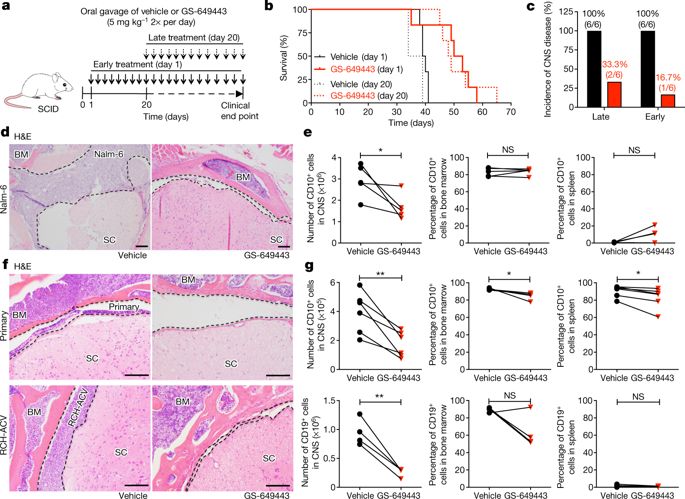Our official English website, www.x-mol.net, welcomes your
feedback! (Note: you will need to create a separate account there.)
Leukaemia hijacks a neural mechanism to invade the central nervous system
Nature ( IF 50.5 ) Pub Date : 2018-07-18 , DOI: 10.1038/s41586-018-0342-5 Hisayuki Yao 1, 2 , Trevor T Price 1 , Gaia Cantelli 1 , Brandon Ngo 1 , Matthew J Warner 1, 3 , Lindsey Olivere 1 , Sarah M Ridge 1 , Elizabeth M Jablonski 4, 5 , Joseph Therrien 6 , Stacey Tannheimer 6 , Chad M McCall 7 , Anjen Chenn 8 , Dorothy A Sipkins 1
Nature ( IF 50.5 ) Pub Date : 2018-07-18 , DOI: 10.1038/s41586-018-0342-5 Hisayuki Yao 1, 2 , Trevor T Price 1 , Gaia Cantelli 1 , Brandon Ngo 1 , Matthew J Warner 1, 3 , Lindsey Olivere 1 , Sarah M Ridge 1 , Elizabeth M Jablonski 4, 5 , Joseph Therrien 6 , Stacey Tannheimer 6 , Chad M McCall 7 , Anjen Chenn 8 , Dorothy A Sipkins 1
Affiliation

|
Acute lymphoblastic leukaemia (ALL) has a marked propensity to metastasize to the central nervous system (CNS). In contrast to brain metastases from solid tumours, metastases of ALL seldom involve the parenchyma but are isolated to the leptomeninges, which is an infrequent site for carcinomatous invasion. Although metastasis to the CNS occurs across all subtypes of ALL, a unifying mechanism for invasion has not yet been determined. Here we show that ALL cells in the circulation are unable to breach the blood–brain barrier in mice; instead, they migrate into the CNS along vessels that pass directly between vertebral or calvarial bone marrow and the subarachnoid space. The basement membrane of these bridging vessels is enriched in laminin, which is known to coordinate pathfinding of neuronal progenitor cells in the CNS. The laminin receptor α6 integrin is expressed in most cases of ALL. We found that α6 integrin–laminin interactions mediated the migration of ALL cells towards the cerebrospinal fluid in vitro. Mice with ALL xenografts were treated with either a PI3Kδ inhibitor, which decreased α6 integrin expression on ALL cells, or specific α6 integrin-neutralizing antibodies and showed significant reductions in ALL transit along bridging vessels, blast counts in the cerebrospinal fluid and CNS disease symptoms despite minimally decreased bone marrow disease burden. Our data suggest that α6 integrin expression, which is common in ALL, allows cells to use neural migratory pathways to invade the CNS.Expression of α6 integrin enables acute lymphoblastic leukaemia cells to use neural migratory pathways to invade the central nervous system and metastasize to the brain.
中文翻译:

白血病劫持神经机制侵入中枢神经系统
急性淋巴细胞白血病 (ALL) 具有明显的转移至中枢神经系统 (CNS) 的倾向。与实体瘤的脑转移相反,ALL 的转移很少累及实质,而是孤立于软脑膜,软脑膜是癌性浸润的罕见部位。尽管 ALL 的所有亚型均发生 CNS 转移,但尚未确定统一的侵袭机制。在这里,我们表明循环中的所有细胞都无法突破小鼠的血脑屏障;相反,它们沿着直接穿过椎骨或颅骨骨髓与蛛网膜下腔之间的血管迁移到中枢神经系统。这些桥接血管的基底膜富含层粘连蛋白,已知层粘连蛋白可协调 CNS 中神经元祖细胞的寻路。层粘连蛋白受体 α6 整合素在大多数 ALL 病例中表达。我们发现 α6 整合素-层粘连蛋白相互作用介导了 ALL 细胞在体外向脑脊液的迁移。具有 ALL 异种移植物的小鼠用 PI3Kδ 抑制剂治疗,它降低了 ALL 细胞上的 α6 整合素表达,或特异性 α6 整合素中和抗体,并显示沿桥血管的 ALL 转运、脑脊液原始细胞计数和 CNS 疾病症状显着减少,尽管最低限度地减少骨髓疾病负担。我们的数据表明,在 ALL 中常见的 α6 整合素表达允许细胞使用神经迁移通路侵入 CNS。
更新日期:2018-07-18
中文翻译:

白血病劫持神经机制侵入中枢神经系统
急性淋巴细胞白血病 (ALL) 具有明显的转移至中枢神经系统 (CNS) 的倾向。与实体瘤的脑转移相反,ALL 的转移很少累及实质,而是孤立于软脑膜,软脑膜是癌性浸润的罕见部位。尽管 ALL 的所有亚型均发生 CNS 转移,但尚未确定统一的侵袭机制。在这里,我们表明循环中的所有细胞都无法突破小鼠的血脑屏障;相反,它们沿着直接穿过椎骨或颅骨骨髓与蛛网膜下腔之间的血管迁移到中枢神经系统。这些桥接血管的基底膜富含层粘连蛋白,已知层粘连蛋白可协调 CNS 中神经元祖细胞的寻路。层粘连蛋白受体 α6 整合素在大多数 ALL 病例中表达。我们发现 α6 整合素-层粘连蛋白相互作用介导了 ALL 细胞在体外向脑脊液的迁移。具有 ALL 异种移植物的小鼠用 PI3Kδ 抑制剂治疗,它降低了 ALL 细胞上的 α6 整合素表达,或特异性 α6 整合素中和抗体,并显示沿桥血管的 ALL 转运、脑脊液原始细胞计数和 CNS 疾病症状显着减少,尽管最低限度地减少骨髓疾病负担。我们的数据表明,在 ALL 中常见的 α6 整合素表达允许细胞使用神经迁移通路侵入 CNS。











































 京公网安备 11010802027423号
京公网安备 11010802027423号